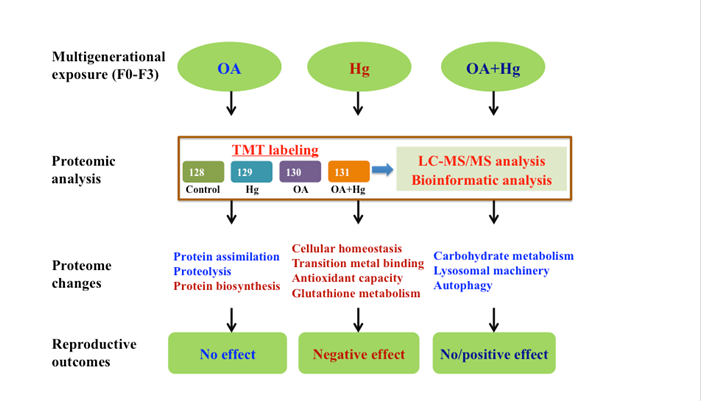作 者:Wang, MH; Lee, JS; Li, Y
影响因子:6.198
刊物名称: ENVIRONMENTAL SCIENCE & TECHNOLOGY
出版年份:2017
卷:51(10) 页码: 5820-5831
Previously, we found that ocean acidification (OA) mitigates mercury (Hg) toxicity to marine copepodTigriopus japonicusunder multigenerational exposure (four generations, F0−F3). To determine the response mechanisms ofT. japonicusagainst long-term exposure to OA and Hg pollution, we investigated the proteome of F3 copepods after multigenerational exposure to four conditions: pCO2 400 μatm + control; pCO2 1000 μatm + control; pCO2 400 μatm +1.0 μg/L Hg; and pCO2 1000 μatm +1.0 μg/L Hg. Functional enrichment analysis indicated that OA enhanced the copepod’s energy production mainly by increasing protein assimilation and proteolysis as a compensatory strategy, which explained its physiological resilience to reduced pH. Conversely, Hg treatment decreased many critical processes, including ferric iron binding, antioxidant activity, cellular homeostasis, and glutathione metabolism, and these toxic events could translate into higher-level responses, i.e., restrained reproduction in copepods. Importantly, the mediation of Hg toxicity inT. japonicusby OA could be explained by the enhanced lysosome-autophagy pathway proteomes that are responsible for repairing and removing damaged proteins and enzymes under stress. Overall, this study provided molecular insights into the response ofT. japonicusto long-term exposure of OA and Hg, with a particular emphasis on the mitigating impact of the CO2-driven acidification on Hg toxicity.

Fig.14.Schematic illustration about the individual/combined impacts of OA and Hg pollution on the copepod proteome, as well as their reproductive outcomes. Please note that blue color represents the up-regulated processes under stress, and red color for the down-regulated processes.

